Business Case: Innovation and Sustainable Development at Danfoss
VerifiedAdded on 2023/06/12
|13
|1666
|149
Case Study
AI Summary
This case study examines Danfoss's approach to innovation and sustainable business development, highlighting the company's strategies for achieving competitive advantage and long-term market sustainability. It covers various aspects, including the challenges faced by Danfoss, the benefits of implementing innovative ideas, and the strategic responses adopted to enhance productivity and profitability. The analysis includes a review of the company's operations, employee participation, and alignment with government regulations. Furthermore, the study identifies key stakeholders and assesses the social, environmental, and economic impacts of Danfoss's initiatives. The financial analysis presents a summary of capital costs, whole-of-life costs, and the benefit-cost ratio, demonstrating the project's overall value. The deliverability of the recommended solutions, including commercial, financial, and management considerations, is also discussed, emphasizing the importance of customer service, marketing strategies, and regulatory compliance. The case study concludes by referencing various academic sources, providing a comprehensive overview of Danfoss's efforts to drive innovation and sustainability within its business model.
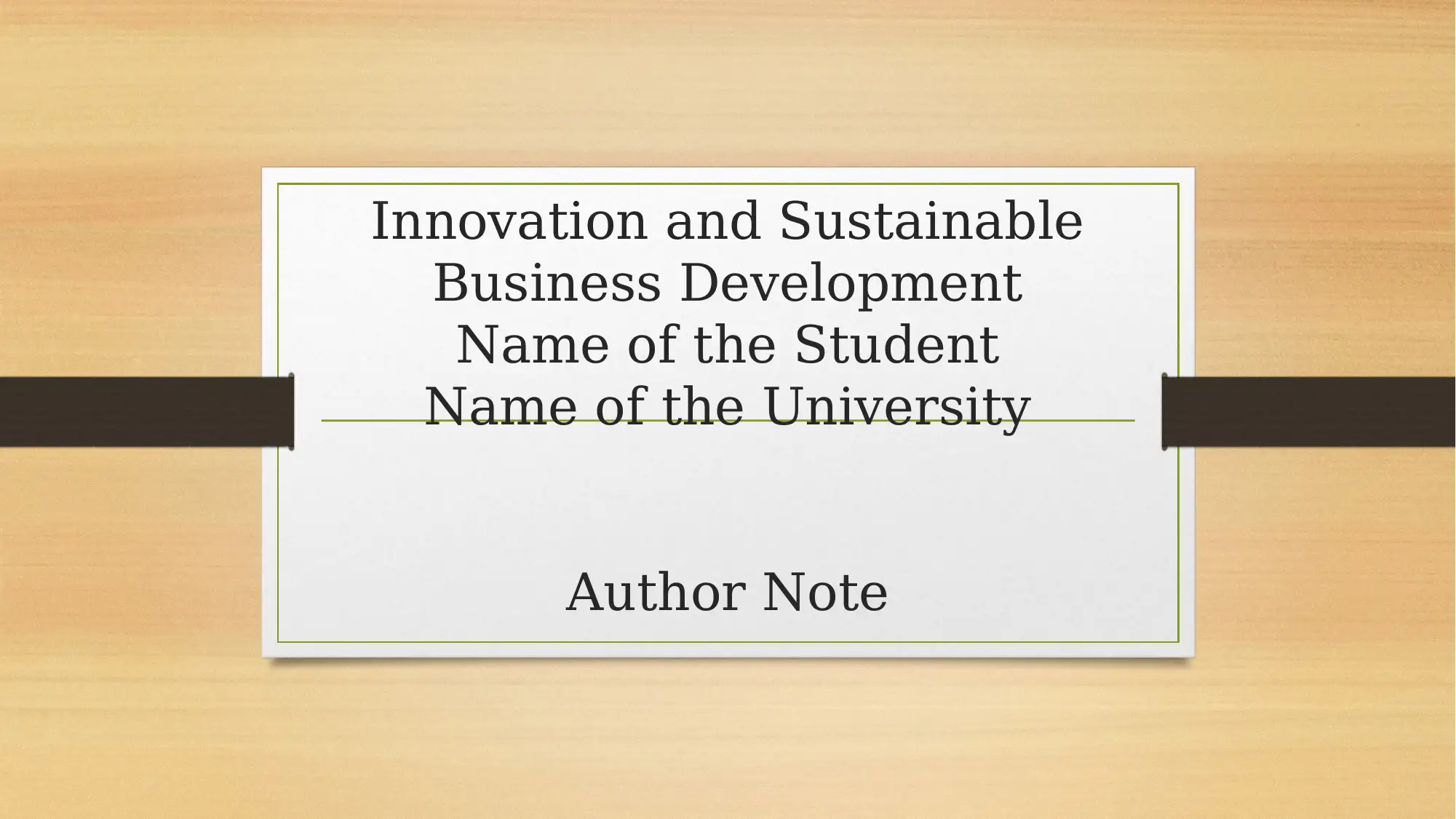
Innovation and Sustainable
Business Development
Name of the Student
Name of the University
Author Note
Business Development
Name of the Student
Name of the University
Author Note
Paraphrase This Document
Need a fresh take? Get an instant paraphrase of this document with our AI Paraphraser
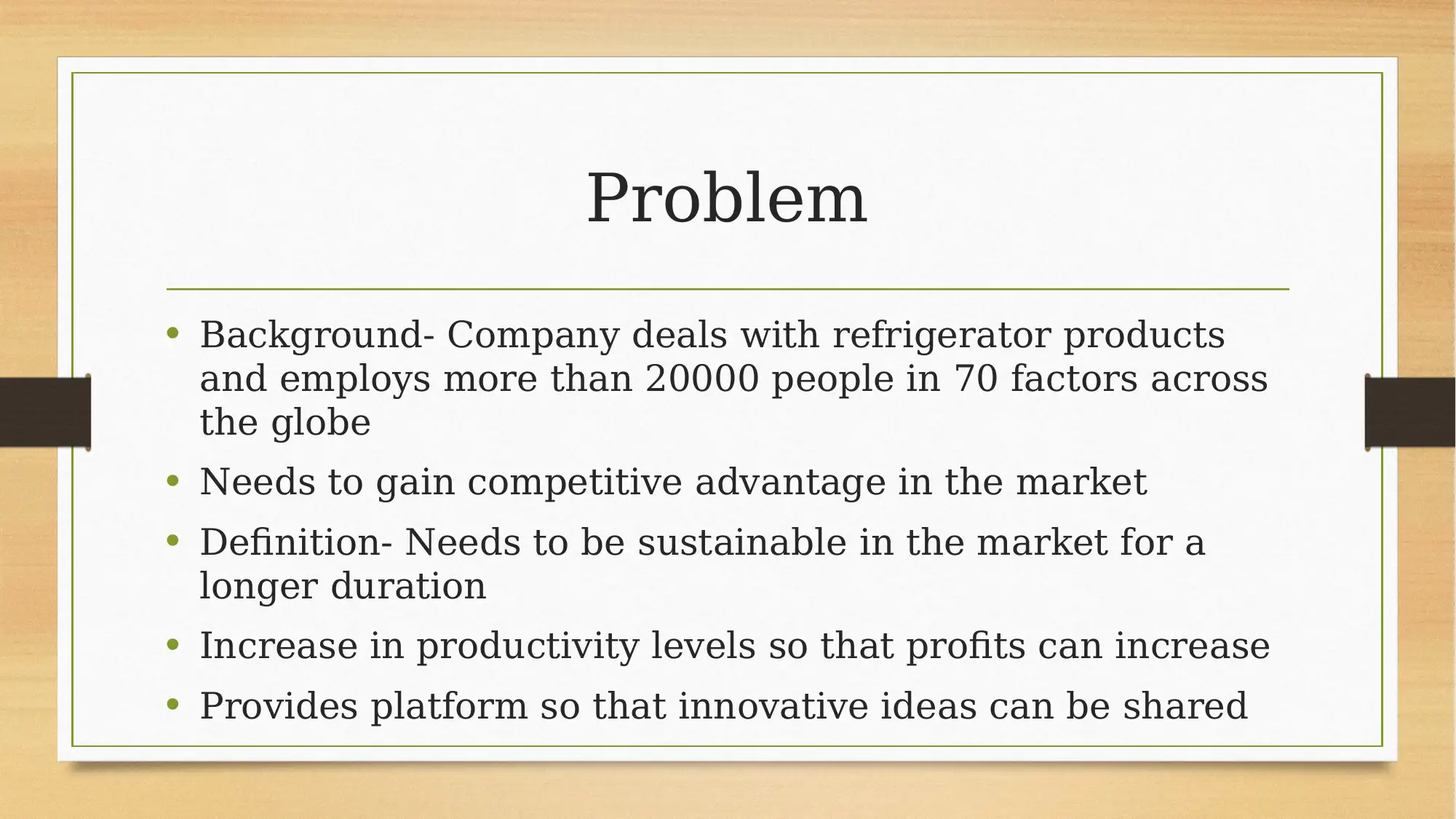
Problem
• Background- Company deals with refrigerator products
and employs more than 20000 people in 70 factors across
the globe
• Needs to gain competitive advantage in the market
• Definition- Needs to be sustainable in the market for a
longer duration
• Increase in productivity levels so that profits can increase
• Provides platform so that innovative ideas can be shared
• Background- Company deals with refrigerator products
and employs more than 20000 people in 70 factors across
the globe
• Needs to gain competitive advantage in the market
• Definition- Needs to be sustainable in the market for a
longer duration
• Increase in productivity levels so that profits can increase
• Provides platform so that innovative ideas can be shared
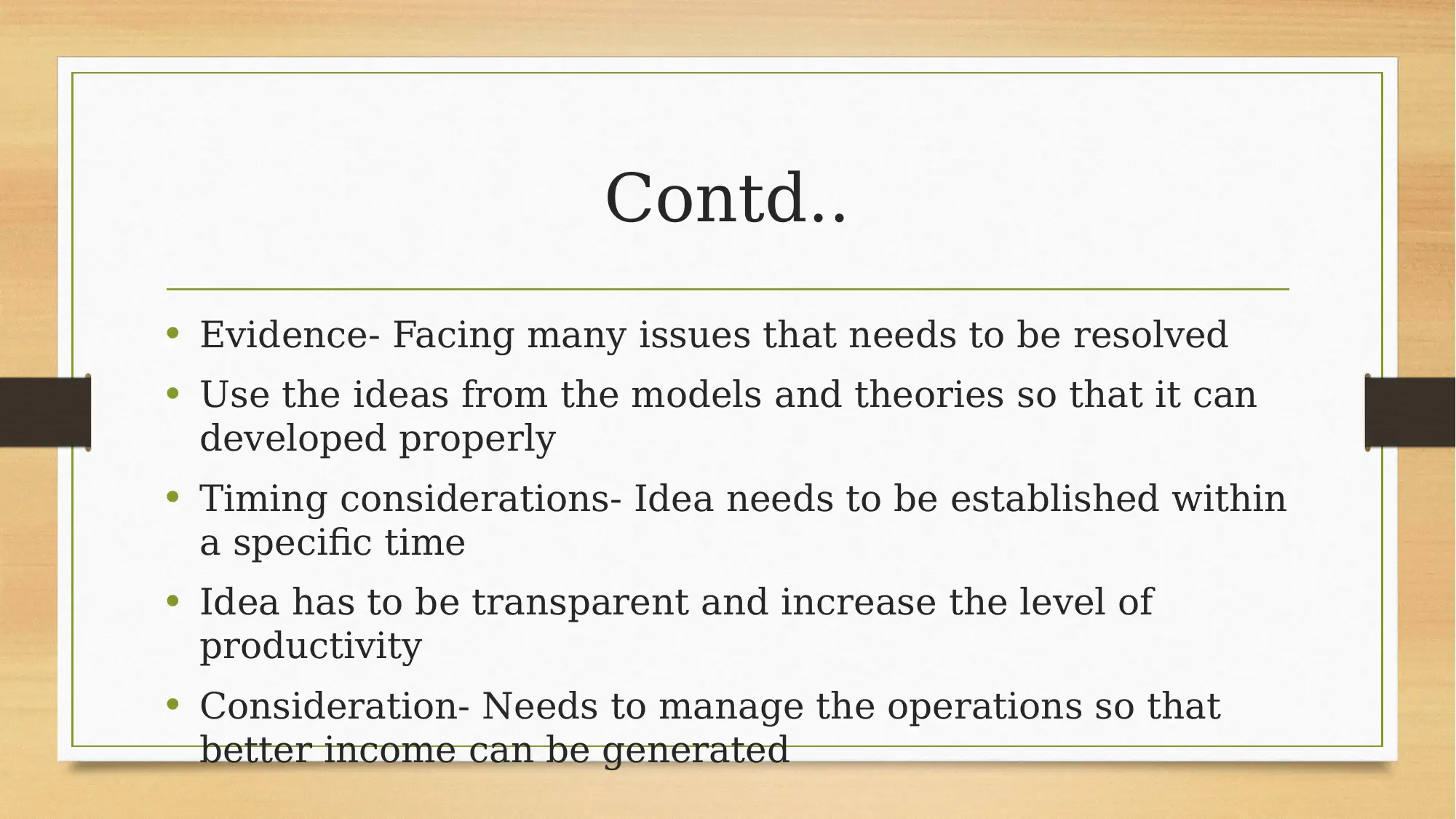
Contd..
• Evidence- Facing many issues that needs to be resolved
• Use the ideas from the models and theories so that it can
developed properly
• Timing considerations- Idea needs to be established within
a specific time
• Idea has to be transparent and increase the level of
productivity
• Consideration- Needs to manage the operations so that
better income can be generated
• Evidence- Facing many issues that needs to be resolved
• Use the ideas from the models and theories so that it can
developed properly
• Timing considerations- Idea needs to be established within
a specific time
• Idea has to be transparent and increase the level of
productivity
• Consideration- Needs to manage the operations so that
better income can be generated
⊘ This is a preview!⊘
Do you want full access?
Subscribe today to unlock all pages.

Trusted by 1+ million students worldwide
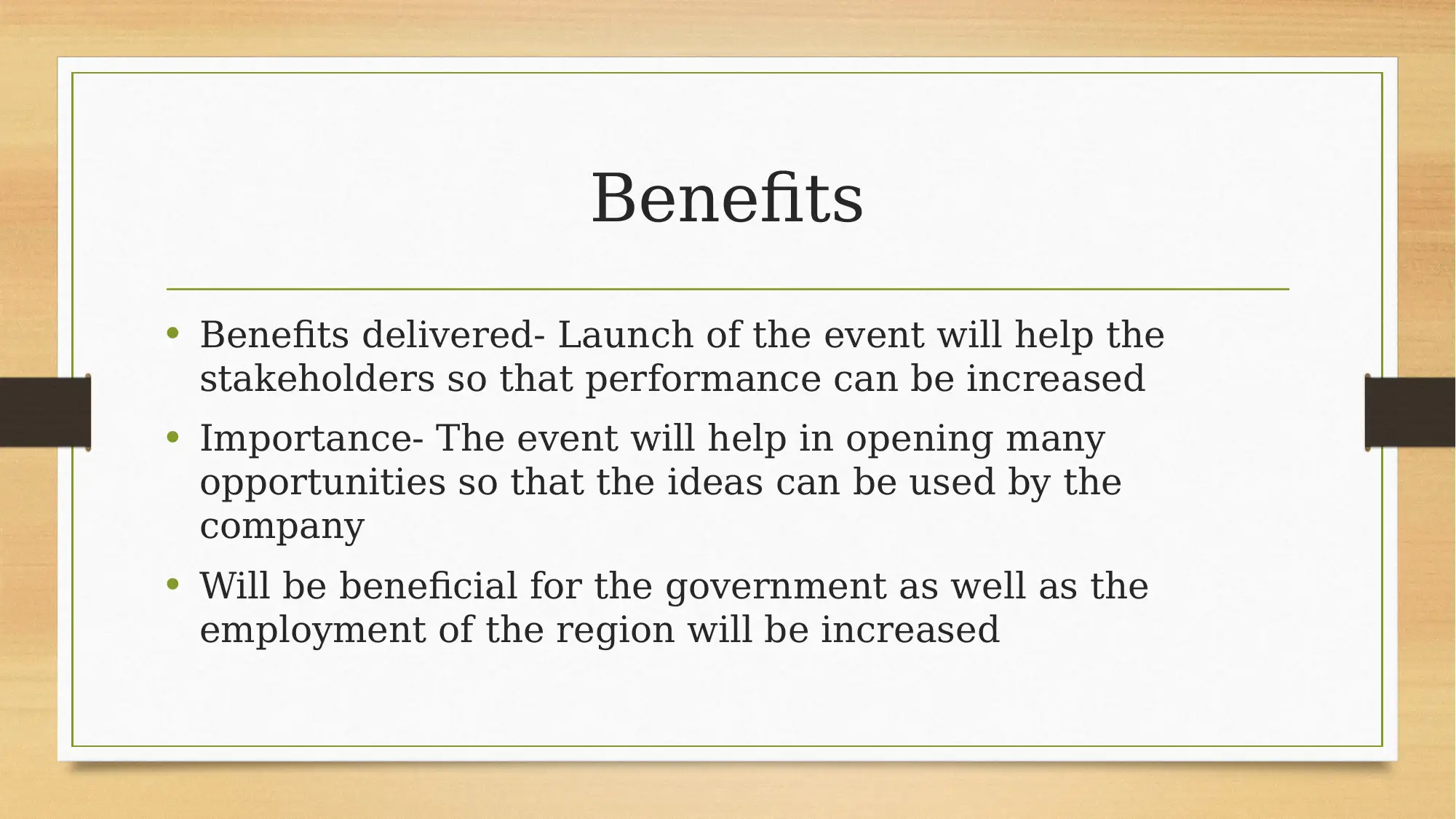
Benefits
• Benefits delivered- Launch of the event will help the
stakeholders so that performance can be increased
• Importance- The event will help in opening many
opportunities so that the ideas can be used by the
company
• Will be beneficial for the government as well as the
employment of the region will be increased
• Benefits delivered- Launch of the event will help the
stakeholders so that performance can be increased
• Importance- The event will help in opening many
opportunities so that the ideas can be used by the
company
• Will be beneficial for the government as well as the
employment of the region will be increased
Paraphrase This Document
Need a fresh take? Get an instant paraphrase of this document with our AI Paraphraser
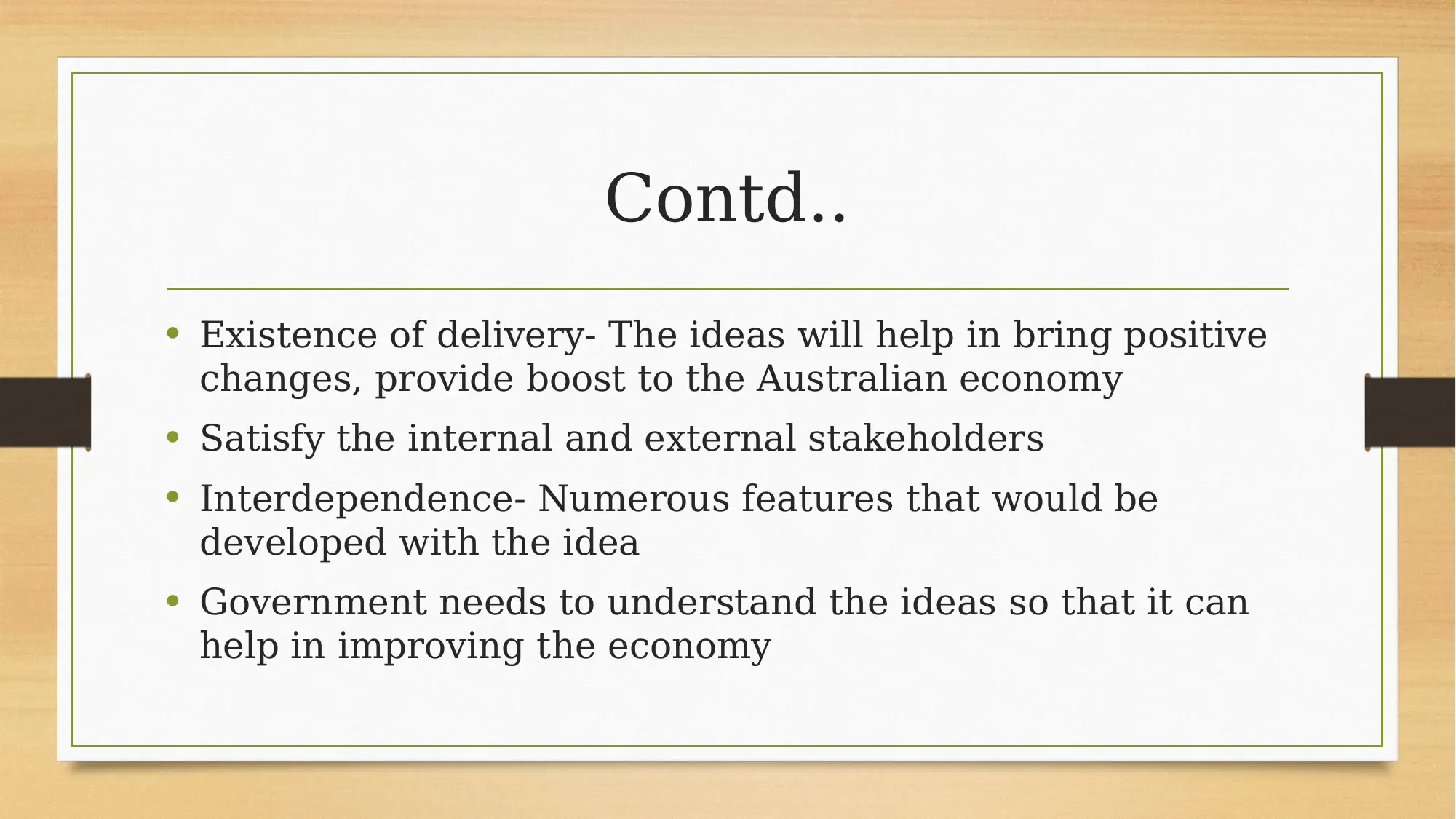
Contd..
• Existence of delivery- The ideas will help in bring positive
changes, provide boost to the Australian economy
• Satisfy the internal and external stakeholders
• Interdependence- Numerous features that would be
developed with the idea
• Government needs to understand the ideas so that it can
help in improving the economy
• Existence of delivery- The ideas will help in bring positive
changes, provide boost to the Australian economy
• Satisfy the internal and external stakeholders
• Interdependence- Numerous features that would be
developed with the idea
• Government needs to understand the ideas so that it can
help in improving the economy
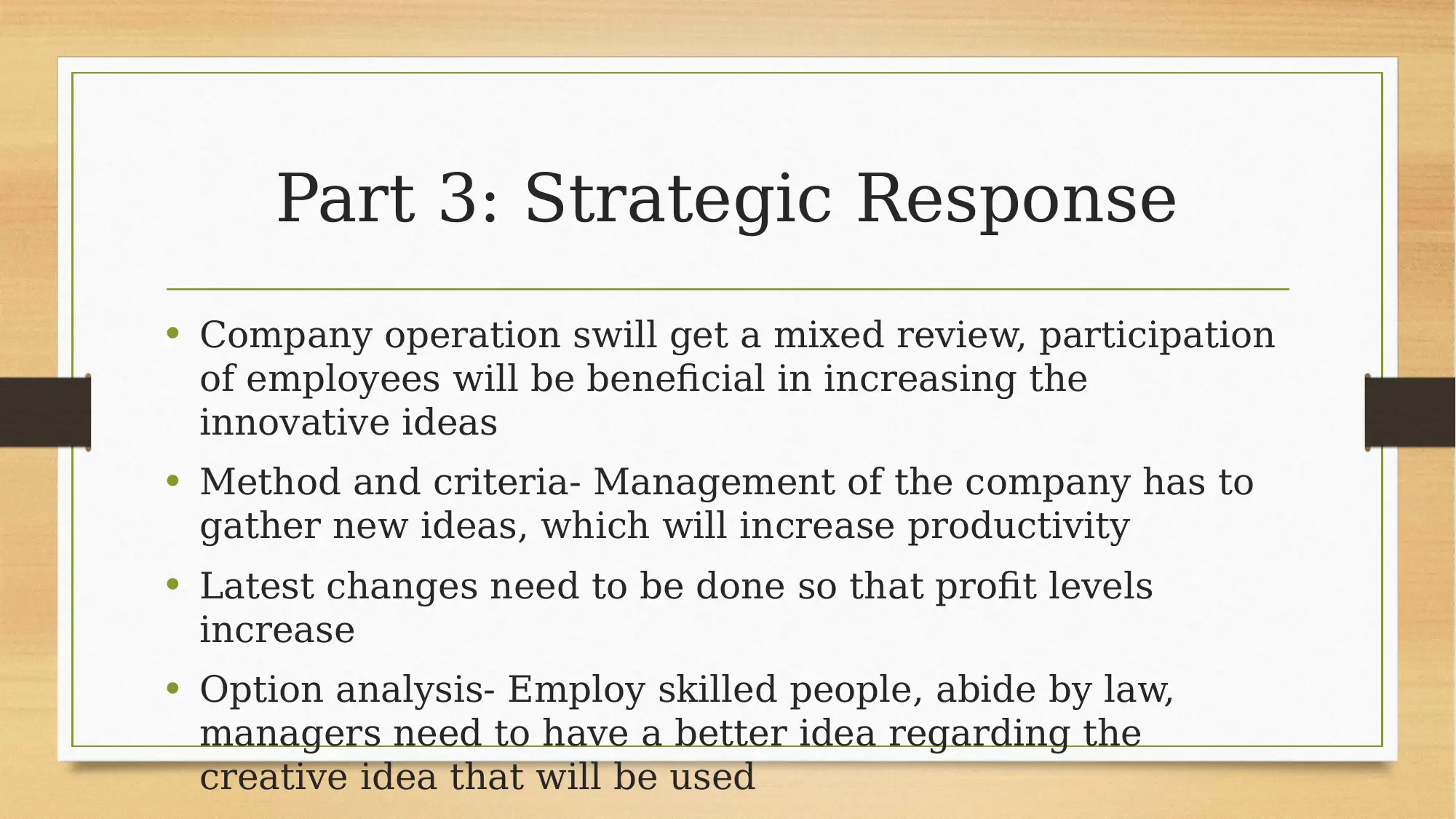
Part 3: Strategic Response
• Company operation swill get a mixed review, participation
of employees will be beneficial in increasing the
innovative ideas
• Method and criteria- Management of the company has to
gather new ideas, which will increase productivity
• Latest changes need to be done so that profit levels
increase
• Option analysis- Employ skilled people, abide by law,
managers need to have a better idea regarding the
creative idea that will be used
• Company operation swill get a mixed review, participation
of employees will be beneficial in increasing the
innovative ideas
• Method and criteria- Management of the company has to
gather new ideas, which will increase productivity
• Latest changes need to be done so that profit levels
increase
• Option analysis- Employ skilled people, abide by law,
managers need to have a better idea regarding the
creative idea that will be used
⊘ This is a preview!⊘
Do you want full access?
Subscribe today to unlock all pages.

Trusted by 1+ million students worldwide
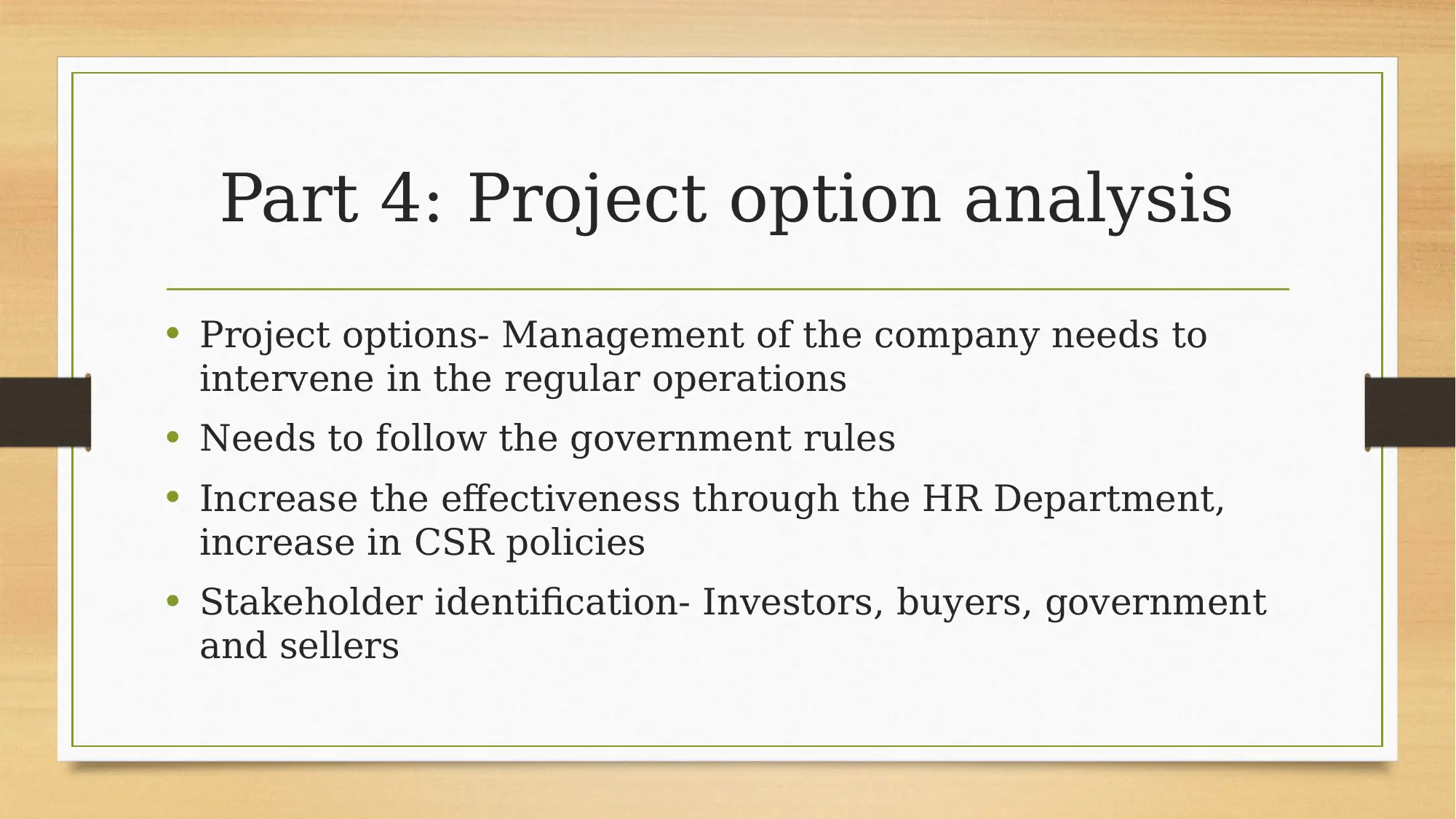
Part 4: Project option analysis
• Project options- Management of the company needs to
intervene in the regular operations
• Needs to follow the government rules
• Increase the effectiveness through the HR Department,
increase in CSR policies
• Stakeholder identification- Investors, buyers, government
and sellers
• Project options- Management of the company needs to
intervene in the regular operations
• Needs to follow the government rules
• Increase the effectiveness through the HR Department,
increase in CSR policies
• Stakeholder identification- Investors, buyers, government
and sellers
Paraphrase This Document
Need a fresh take? Get an instant paraphrase of this document with our AI Paraphraser
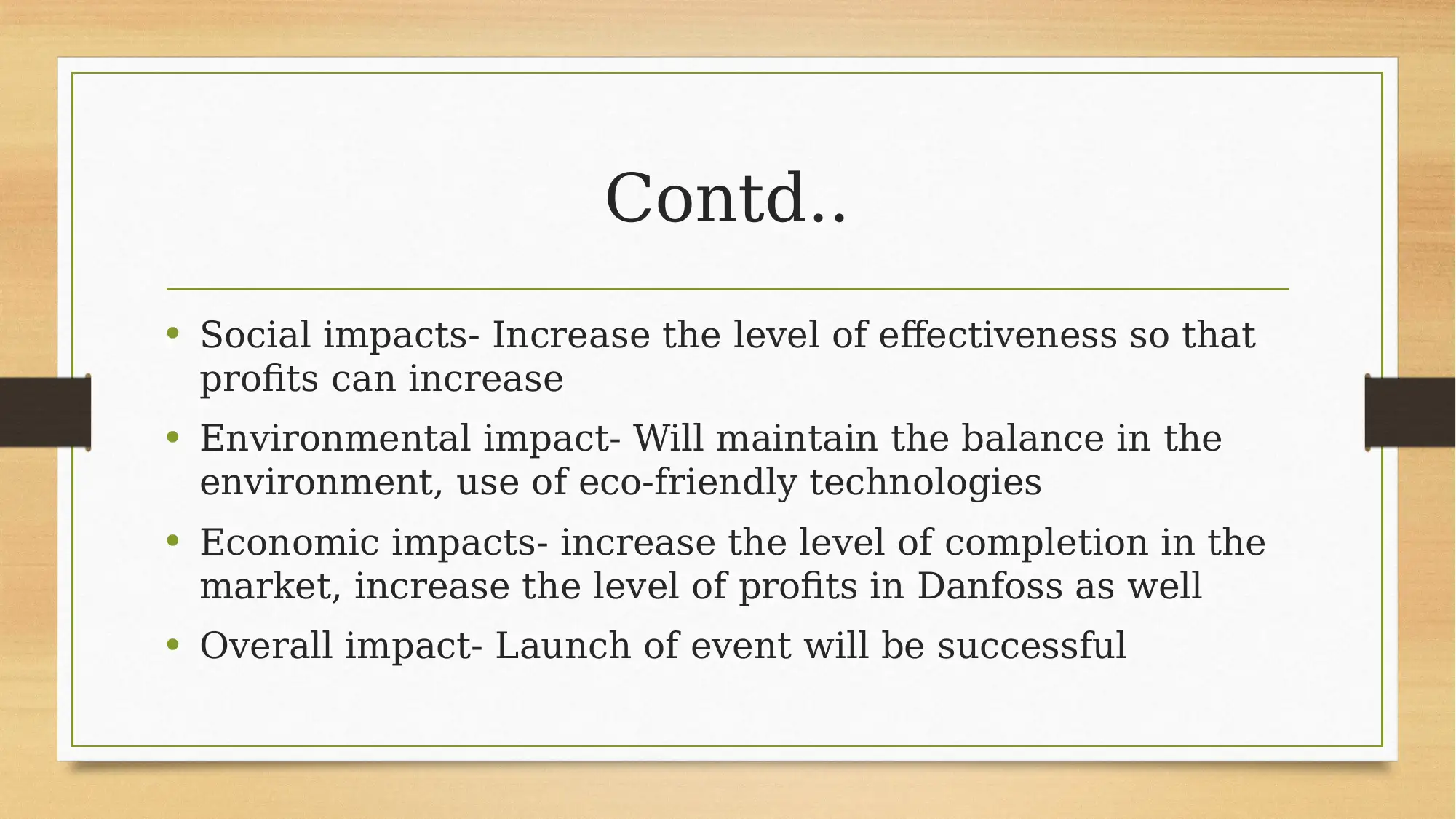
Contd..
• Social impacts- Increase the level of effectiveness so that
profits can increase
• Environmental impact- Will maintain the balance in the
environment, use of eco-friendly technologies
• Economic impacts- increase the level of completion in the
market, increase the level of profits in Danfoss as well
• Overall impact- Launch of event will be successful
• Social impacts- Increase the level of effectiveness so that
profits can increase
• Environmental impact- Will maintain the balance in the
environment, use of eco-friendly technologies
• Economic impacts- increase the level of completion in the
market, increase the level of profits in Danfoss as well
• Overall impact- Launch of event will be successful
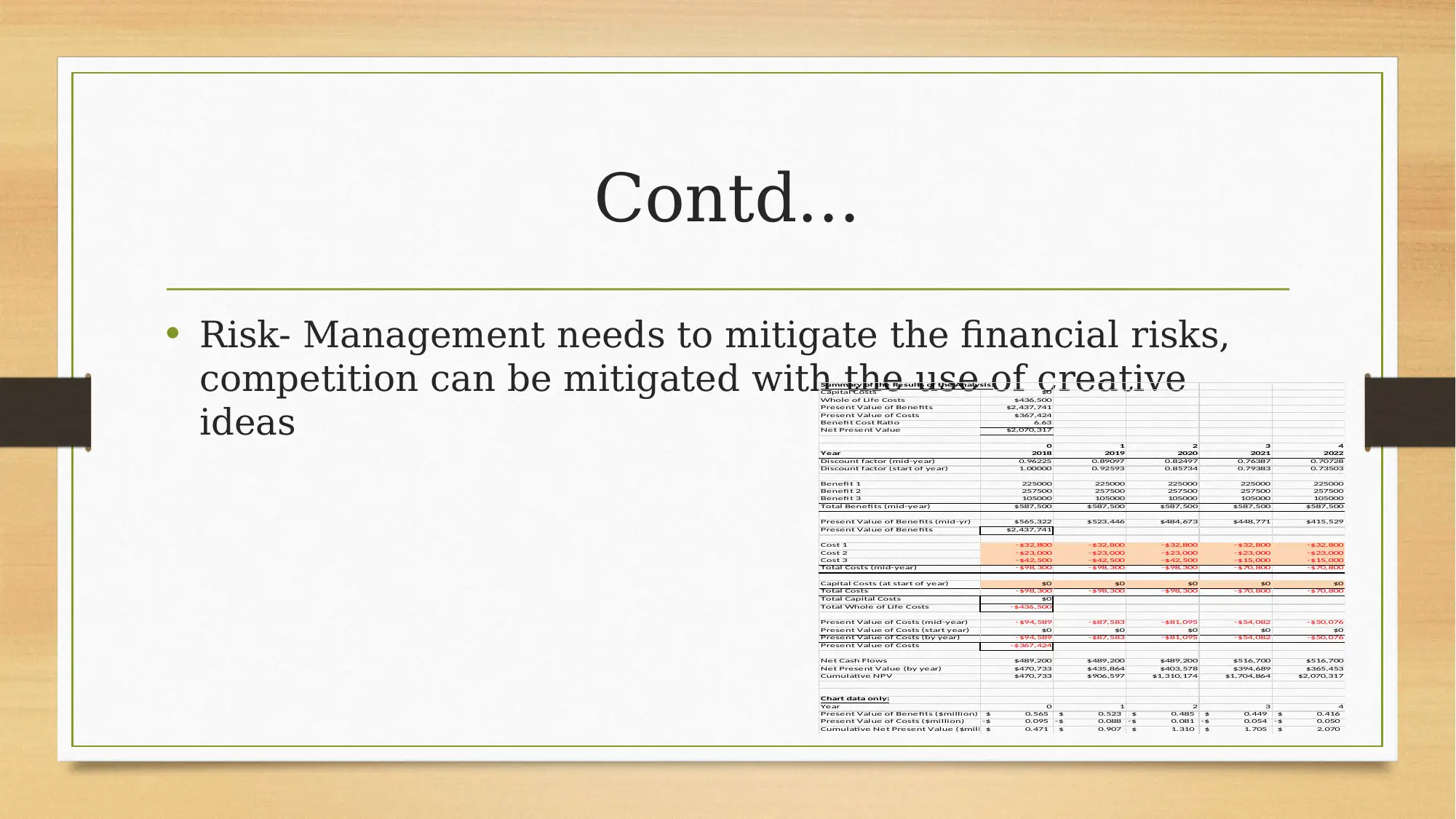
Contd...
• Risk- Management needs to mitigate the financial risks,
competition can be mitigated with the use of creative
ideas
Summary of the Results of the Analysis:
Capital Costs $0
Whole of Life Costs $436,500
Present Value of Benefits $2,437,741
Present Value of Costs $367,424
Benefit Cost Ratio 6.63
Net Present Value $2,070,317
0 1 2 3 4
Year 2018 2019 2020 2021 2022
Discount factor (mid-year) 0.96225 0.89097 0.82497 0.76387 0.70728
Discount factor (start of year) 1.00000 0.92593 0.85734 0.79383 0.73503
Benefit 1 225000 225000 225000 225000 225000
Benefit 2 257500 257500 257500 257500 257500
Benefit 3 105000 105000 105000 105000 105000
Total Benefits (mid-year) $587,500 $587,500 $587,500 $587,500 $587,500
Present Value of Benefits (mid-yr) $565,322 $523,446 $484,673 $448,771 $415,529
Present Value of Benefits $2,437,741
Cost 1 -$32,800 -$32,800 -$32,800 -$32,800 -$32,800
Cost 2 -$23,000 -$23,000 -$23,000 -$23,000 -$23,000
Cost 3 -$42,500 -$42,500 -$42,500 -$15,000 -$15,000
Total Costs (mid-year) -$98,300 -$98,300 -$98,300 -$70,800 -$70,800
Capital Costs (at start of year) $0 $0 $0 $0 $0
Total Costs -$98,300 -$98,300 -$98,300 -$70,800 -$70,800
Total Capital Costs $0
Total Whole of Life Costs -$436,500
Present Value of Costs (mid-year) -$94,589 -$87,583 -$81,095 -$54,082 -$50,076
Present Value of Costs (start year) $0 $0 $0 $0 $0
Present Value of Costs (by year) -$94,589 -$87,583 -$81,095 -$54,082 -$50,076
Present Value of Costs -$367,424
Net Cash Flows $489,200 $489,200 $489,200 $516,700 $516,700
Net Present Value (by year) $470,733 $435,864 $403,578 $394,689 $365,453
Cumulative NPV $470,733 $906,597 $1,310,174 $1,704,864 $2,070,317
Chart data only:
Year 0 1 2 3 4
Present Value of Benefits ($million) 0.565$ 0.523$ 0.485$ 0.449$ 0.416$
Present Value of Costs ($million) 0.095-$ 0.088-$ 0.081-$ 0.054-$ 0.050-$
Cumulative Net Present Value ($million) 0.471$ 0.907$ 1.310$ 1.705$ 2.070$
• Risk- Management needs to mitigate the financial risks,
competition can be mitigated with the use of creative
ideas
Summary of the Results of the Analysis:
Capital Costs $0
Whole of Life Costs $436,500
Present Value of Benefits $2,437,741
Present Value of Costs $367,424
Benefit Cost Ratio 6.63
Net Present Value $2,070,317
0 1 2 3 4
Year 2018 2019 2020 2021 2022
Discount factor (mid-year) 0.96225 0.89097 0.82497 0.76387 0.70728
Discount factor (start of year) 1.00000 0.92593 0.85734 0.79383 0.73503
Benefit 1 225000 225000 225000 225000 225000
Benefit 2 257500 257500 257500 257500 257500
Benefit 3 105000 105000 105000 105000 105000
Total Benefits (mid-year) $587,500 $587,500 $587,500 $587,500 $587,500
Present Value of Benefits (mid-yr) $565,322 $523,446 $484,673 $448,771 $415,529
Present Value of Benefits $2,437,741
Cost 1 -$32,800 -$32,800 -$32,800 -$32,800 -$32,800
Cost 2 -$23,000 -$23,000 -$23,000 -$23,000 -$23,000
Cost 3 -$42,500 -$42,500 -$42,500 -$15,000 -$15,000
Total Costs (mid-year) -$98,300 -$98,300 -$98,300 -$70,800 -$70,800
Capital Costs (at start of year) $0 $0 $0 $0 $0
Total Costs -$98,300 -$98,300 -$98,300 -$70,800 -$70,800
Total Capital Costs $0
Total Whole of Life Costs -$436,500
Present Value of Costs (mid-year) -$94,589 -$87,583 -$81,095 -$54,082 -$50,076
Present Value of Costs (start year) $0 $0 $0 $0 $0
Present Value of Costs (by year) -$94,589 -$87,583 -$81,095 -$54,082 -$50,076
Present Value of Costs -$367,424
Net Cash Flows $489,200 $489,200 $489,200 $516,700 $516,700
Net Present Value (by year) $470,733 $435,864 $403,578 $394,689 $365,453
Cumulative NPV $470,733 $906,597 $1,310,174 $1,704,864 $2,070,317
Chart data only:
Year 0 1 2 3 4
Present Value of Benefits ($million) 0.565$ 0.523$ 0.485$ 0.449$ 0.416$
Present Value of Costs ($million) 0.095-$ 0.088-$ 0.081-$ 0.054-$ 0.050-$
Cumulative Net Present Value ($million) 0.471$ 0.907$ 1.310$ 1.705$ 2.070$
⊘ This is a preview!⊘
Do you want full access?
Subscribe today to unlock all pages.

Trusted by 1+ million students worldwide
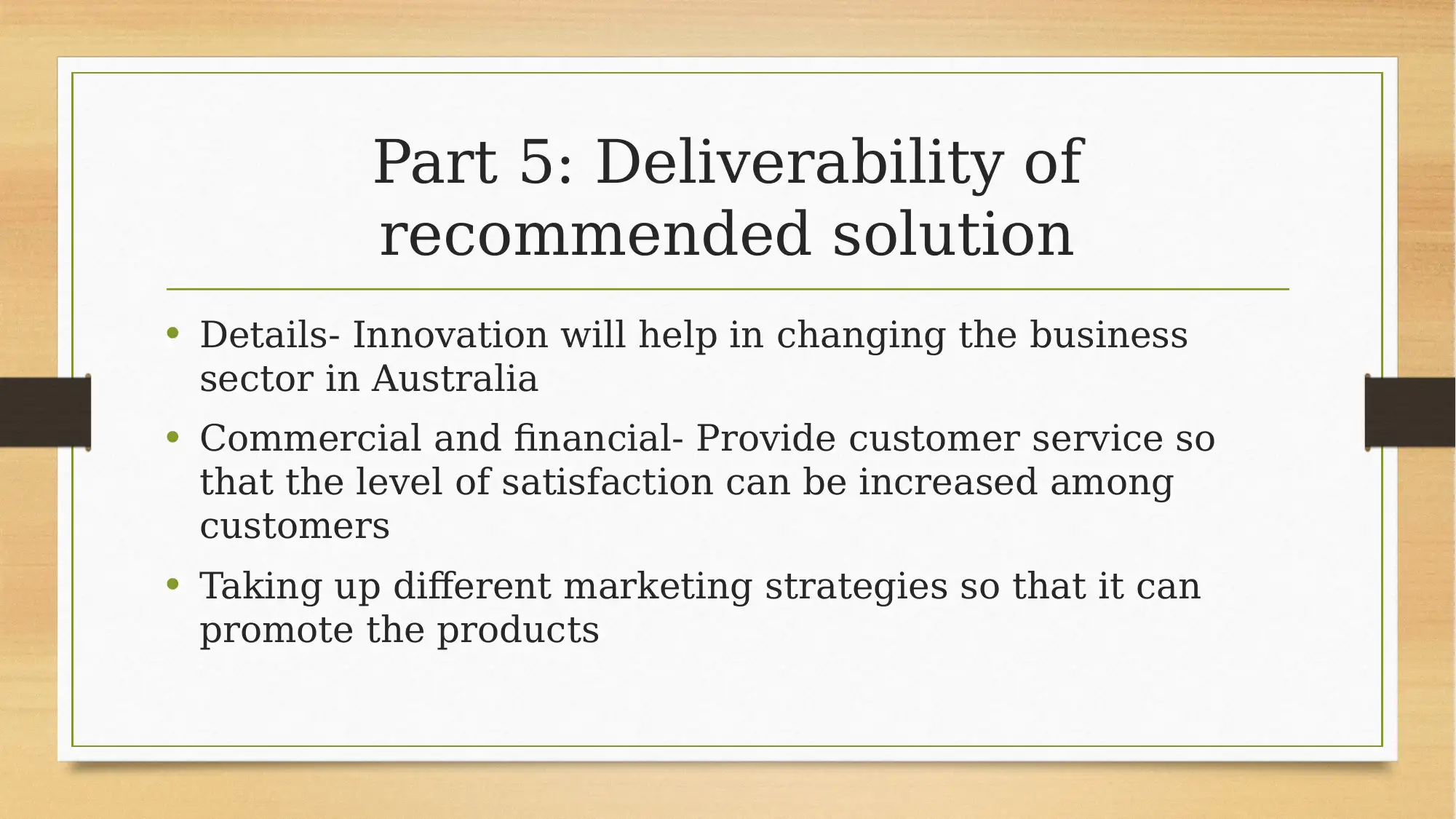
Part 5: Deliverability of
recommended solution
• Details- Innovation will help in changing the business
sector in Australia
• Commercial and financial- Provide customer service so
that the level of satisfaction can be increased among
customers
• Taking up different marketing strategies so that it can
promote the products
recommended solution
• Details- Innovation will help in changing the business
sector in Australia
• Commercial and financial- Provide customer service so
that the level of satisfaction can be increased among
customers
• Taking up different marketing strategies so that it can
promote the products
Paraphrase This Document
Need a fresh take? Get an instant paraphrase of this document with our AI Paraphraser
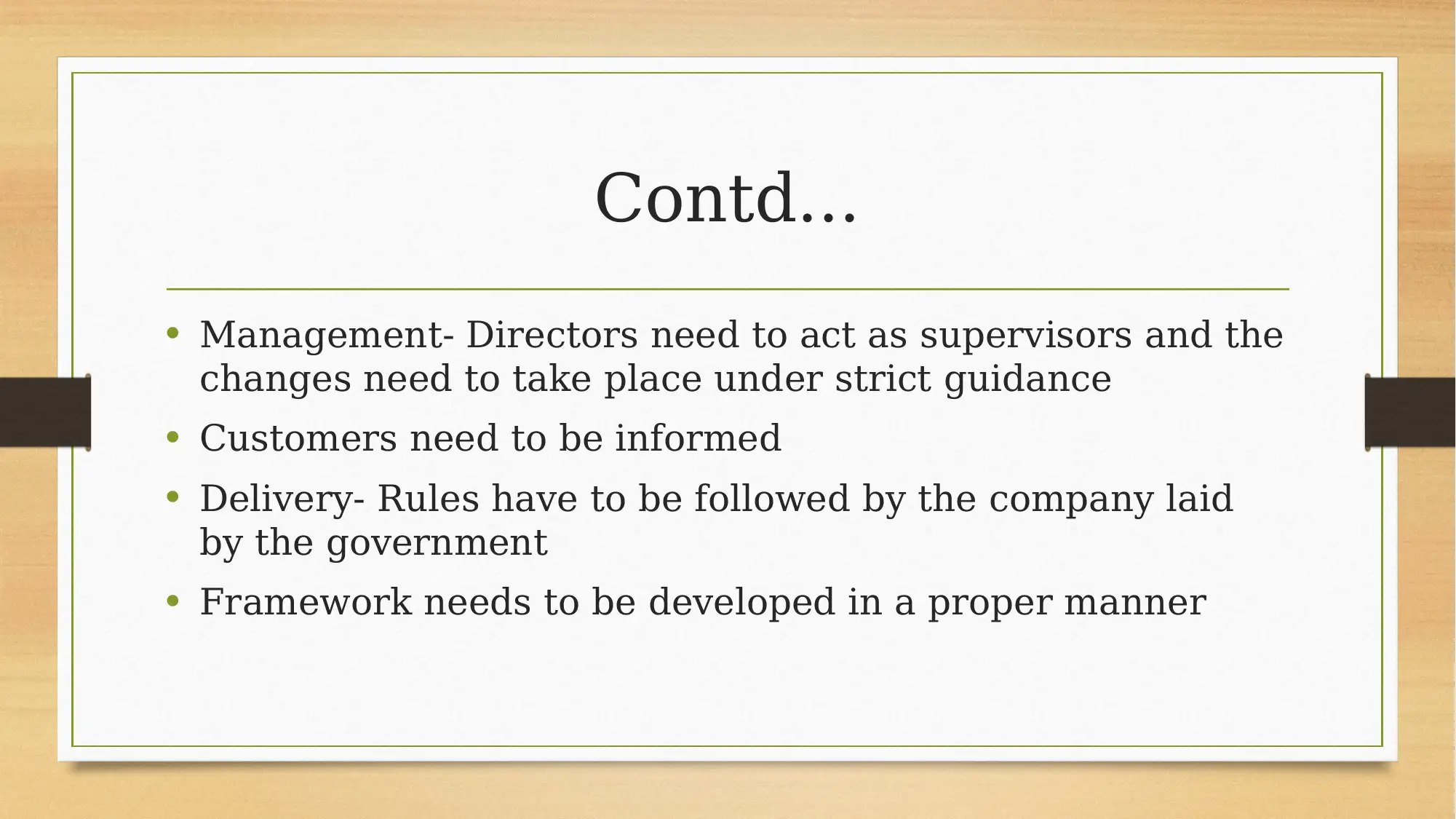
Contd...
• Management- Directors need to act as supervisors and the
changes need to take place under strict guidance
• Customers need to be informed
• Delivery- Rules have to be followed by the company laid
by the government
• Framework needs to be developed in a proper manner
• Management- Directors need to act as supervisors and the
changes need to take place under strict guidance
• Customers need to be informed
• Delivery- Rules have to be followed by the company laid
by the government
• Framework needs to be developed in a proper manner
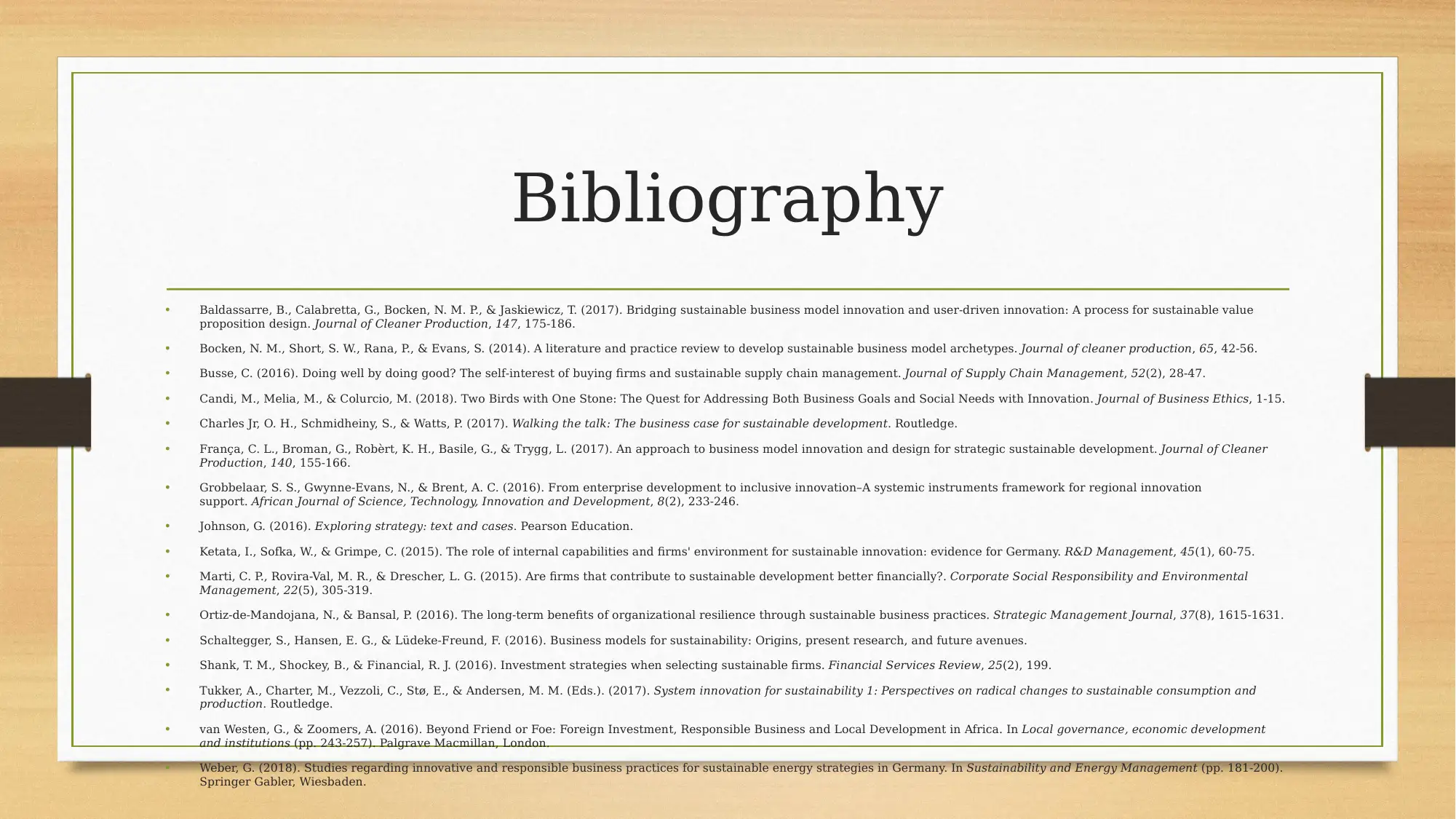
Bibliography
• Baldassarre, B., Calabretta, G., Bocken, N. M. P., & Jaskiewicz, T. (2017). Bridging sustainable business model innovation and user-driven innovation: A process for sustainable value
proposition design. Journal of Cleaner Production, 147, 175-186.
• Bocken, N. M., Short, S. W., Rana, P., & Evans, S. (2014). A literature and practice review to develop sustainable business model archetypes. Journal of cleaner production, 65, 42-56.
• Busse, C. (2016). Doing well by doing good? The self‐interest of buying firms and sustainable supply chain management. Journal of Supply Chain Management, 52(2), 28-47.
• Candi, M., Melia, M., & Colurcio, M. (2018). Two Birds with One Stone: The Quest for Addressing Both Business Goals and Social Needs with Innovation. Journal of Business Ethics, 1-15.
• Charles Jr, O. H., Schmidheiny, S., & Watts, P. (2017). Walking the talk: The business case for sustainable development. Routledge.
• França, C. L., Broman, G., Robèrt, K. H., Basile, G., & Trygg, L. (2017). An approach to business model innovation and design for strategic sustainable development. Journal of Cleaner
Production, 140, 155-166.
• Grobbelaar, S. S., Gwynne-Evans, N., & Brent, A. C. (2016). From enterprise development to inclusive innovation–A systemic instruments framework for regional innovation
support. African Journal of Science, Technology, Innovation and Development, 8(2), 233-246.
• Johnson, G. (2016). Exploring strategy: text and cases. Pearson Education.
• Ketata, I., Sofka, W., & Grimpe, C. (2015). The role of internal capabilities and firms' environment for sustainable innovation: evidence for Germany. R&D Management, 45(1), 60-75.
• Marti, C. P., Rovira‐Val, M. R., & Drescher, L. G. (2015). Are firms that contribute to sustainable development better financially?. Corporate Social Responsibility and Environmental
Management, 22(5), 305-319.
• Ortiz‐de‐Mandojana, N., & Bansal, P. (2016). The long‐term benefits of organizational resilience through sustainable business practices. Strategic Management Journal, 37(8), 1615-1631.
• Schaltegger, S., Hansen, E. G., & Lüdeke-Freund, F. (2016). Business models for sustainability: Origins, present research, and future avenues.
• Shank, T. M., Shockey, B., & Financial, R. J. (2016). Investment strategies when selecting sustainable firms. Financial Services Review, 25(2), 199.
• Tukker, A., Charter, M., Vezzoli, C., Stø, E., & Andersen, M. M. (Eds.). (2017). System innovation for sustainability 1: Perspectives on radical changes to sustainable consumption and
production. Routledge.
• van Westen, G., & Zoomers, A. (2016). Beyond Friend or Foe: Foreign Investment, Responsible Business and Local Development in Africa. In Local governance, economic development
and institutions (pp. 243-257). Palgrave Macmillan, London.
• Weber, G. (2018). Studies regarding innovative and responsible business practices for sustainable energy strategies in Germany. In Sustainability and Energy Management (pp. 181-200).
Springer Gabler, Wiesbaden.
• Baldassarre, B., Calabretta, G., Bocken, N. M. P., & Jaskiewicz, T. (2017). Bridging sustainable business model innovation and user-driven innovation: A process for sustainable value
proposition design. Journal of Cleaner Production, 147, 175-186.
• Bocken, N. M., Short, S. W., Rana, P., & Evans, S. (2014). A literature and practice review to develop sustainable business model archetypes. Journal of cleaner production, 65, 42-56.
• Busse, C. (2016). Doing well by doing good? The self‐interest of buying firms and sustainable supply chain management. Journal of Supply Chain Management, 52(2), 28-47.
• Candi, M., Melia, M., & Colurcio, M. (2018). Two Birds with One Stone: The Quest for Addressing Both Business Goals and Social Needs with Innovation. Journal of Business Ethics, 1-15.
• Charles Jr, O. H., Schmidheiny, S., & Watts, P. (2017). Walking the talk: The business case for sustainable development. Routledge.
• França, C. L., Broman, G., Robèrt, K. H., Basile, G., & Trygg, L. (2017). An approach to business model innovation and design for strategic sustainable development. Journal of Cleaner
Production, 140, 155-166.
• Grobbelaar, S. S., Gwynne-Evans, N., & Brent, A. C. (2016). From enterprise development to inclusive innovation–A systemic instruments framework for regional innovation
support. African Journal of Science, Technology, Innovation and Development, 8(2), 233-246.
• Johnson, G. (2016). Exploring strategy: text and cases. Pearson Education.
• Ketata, I., Sofka, W., & Grimpe, C. (2015). The role of internal capabilities and firms' environment for sustainable innovation: evidence for Germany. R&D Management, 45(1), 60-75.
• Marti, C. P., Rovira‐Val, M. R., & Drescher, L. G. (2015). Are firms that contribute to sustainable development better financially?. Corporate Social Responsibility and Environmental
Management, 22(5), 305-319.
• Ortiz‐de‐Mandojana, N., & Bansal, P. (2016). The long‐term benefits of organizational resilience through sustainable business practices. Strategic Management Journal, 37(8), 1615-1631.
• Schaltegger, S., Hansen, E. G., & Lüdeke-Freund, F. (2016). Business models for sustainability: Origins, present research, and future avenues.
• Shank, T. M., Shockey, B., & Financial, R. J. (2016). Investment strategies when selecting sustainable firms. Financial Services Review, 25(2), 199.
• Tukker, A., Charter, M., Vezzoli, C., Stø, E., & Andersen, M. M. (Eds.). (2017). System innovation for sustainability 1: Perspectives on radical changes to sustainable consumption and
production. Routledge.
• van Westen, G., & Zoomers, A. (2016). Beyond Friend or Foe: Foreign Investment, Responsible Business and Local Development in Africa. In Local governance, economic development
and institutions (pp. 243-257). Palgrave Macmillan, London.
• Weber, G. (2018). Studies regarding innovative and responsible business practices for sustainable energy strategies in Germany. In Sustainability and Energy Management (pp. 181-200).
Springer Gabler, Wiesbaden.
⊘ This is a preview!⊘
Do you want full access?
Subscribe today to unlock all pages.

Trusted by 1+ million students worldwide
1 out of 13
Related Documents
Your All-in-One AI-Powered Toolkit for Academic Success.
+13062052269
info@desklib.com
Available 24*7 on WhatsApp / Email
![[object Object]](/_next/static/media/star-bottom.7253800d.svg)
Unlock your academic potential
Copyright © 2020–2025 A2Z Services. All Rights Reserved. Developed and managed by ZUCOL.





